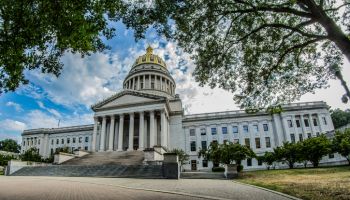Smithsonian Curators Scout for Obama Artifacts
WASHINGTON (AP) — As crowds descended and the inauguration unfolded, a few museum curators in Washington kept watch for symbols and messages that would make history.
The Smithsonian’s National Museum of African American History and Culture will open during President Barack Obama‘s second term, and one section will feature a large display about the first black president. Curators have been working since 2008 to gather objects, documents and images that capture his place in history.
Curator William Pretzer ventured into the crowd Monday, mostly looking for memorabilia that had a personal touch — beyond the T-shirts and buttons hawked by vendors. Pretzer was most interested in handmade items, but he didn’t find much.
“There’s so much commercially produced stuff that people don’t go to the trouble anymore,” he said. “It’s the personal expression, as opposed to the commercial” that the museum most wants to display.
Among the masses of people, Ollie Parham, 55, and her fellow travelers stood out in their bright yellow Alabama NAACP sweatshirts. She rode all night in a tour bus, nearly 19 hours from Huntsville, Ala., to witness Obama’s oath-taking.
Pretzer told her about the museum’s collection effort and asked whether Parham might donate any memorabilia later. She said she would think about it; she had another all-night drive home to get through first.
Shortly afterward, the curator stopped Larry Holmes, 56, of Washington, who was waving an American flag with an inauguration seal imprinted on the stripes. Holmes bought a similar souvenir flag at Obama’s 2009 inauguration. Pretzer took Holmes’ picture and handed him a donation card, in case he might donate the flags later.
When Peggy Shamley Christian, a retired teacher from Chesapeake, Va., heard about the collection effort, she dug through her purse to find an Obama magnet. Pretzer gladly accepted the tiny gift.
Christian said she worked to mobilize voters for Obama’s re-election and was thrilled to celebrate the inaugural.
“It just makes me feel like I’m a part of something wonderful,” she said.
“Instead of being considered a second-class citizen, we all have it going on now,” added Christian, who is black. “We all can stand up and be proud.”
Keeping an eye out for the unusual, Pretzer spotted a man pulling two life-sized cutouts of the president and first lady on a cart through the crowd. He flagged down Ian Davis, 43, of Baltimore and asked whether he might donate the cutouts later.
Davis had been allowing visitors to take pictures with the “Obamas” for a donation.
“You gotta make a dollar,” he said, adding that he hauled the cutouts onto the National Mall “so I can see it, be it and participate.”
Police eventually kicked him off the mall for asking for money. Now, Davis’ cardboard images might be fit for a museum. He said he would donate them if his wife approves.
The museum has amassed more than 300 Obama-related items, including furniture from a 2008 campaign office in northern Virginia and a cloth banner from Tanzania with an Obama portrait and message reading “Congratulations Barack Obama.”
Curators might also try to acquire items from the inauguration platform, including, perhaps, the invocation written by Myrlie Evers-Williams, the widow of slain civil rights activist Medgar Evers. Evers was gunned down 50 years ago in the driveway of his Mississippi home. That history became a link between Obama and the civil rights era.
When the museum opens in 2015 near the Washington Monument, one floor will be devoted to a chronology of African-American history, from 16th century slavery through the Civil War, Reconstruction, the civil rights era and beyond. The timeline will end with Obama and the 2008 election as a symbolic moment.
“Portraying a living individual is always more challenging,” Pretzer said. “You don’t have the perspective, and you don’t have all the evidence.”
The exhibits can evolve later to show Obama’s impact and what comes next.
In planning for the future display, Pretzer and other curators listened closely to Obama’s inauguration speech.
“Part of the dynamic is no longer, if it ever were, white and black. The dynamic is now generational. It is gender; he mentioned gay rights, so sexuality; as well as race,” Pretzer said. “It was an ‘E Pluribus Unum’ speech. It was ‘out of many, one.'”
Museum Director Lonnie Bunch said Obama’s speech was more progressive and aggressive than his first inaugural. It framed the ongoing issues of women’s rights, gay rights and immigration in the context of the historic struggle for equality.
“It reminded people that the story of America is not just about today and tomorrow, but it’s also about yesterday,” Bunch said. “The way he framed his discussion was: ‘This history is not a black history. This is a history that has transformed America.’
“The question becomes, how effective is his administration as a model for what the presidency can accomplish?”
(Photo: AP)
















